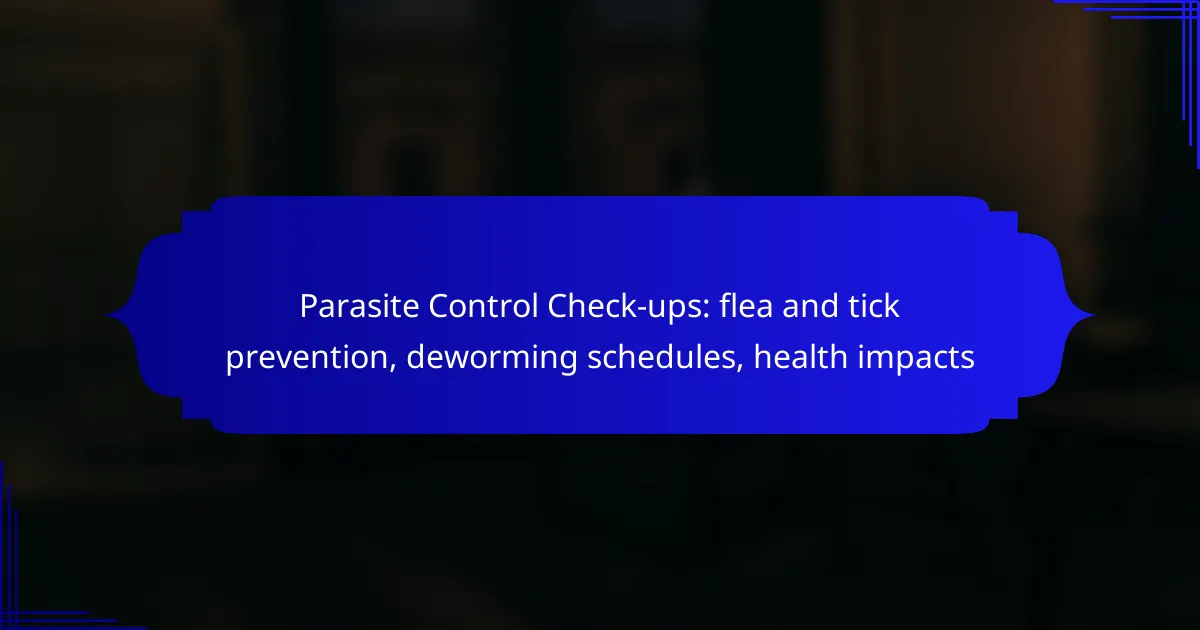Regular parasite control check-ups are essential for maintaining your pet’s health, focusing on flea and tick prevention as well as deworming schedules. Effective strategies include a combination of topical treatments, oral medications, and consistent grooming practices to keep both pets and homes parasite-free. Neglecting these measures can lead to significant health issues, as common parasites can cause discomfort and serious complications if left untreated.

How can I prevent fleas and ticks in Australia?
Preventing fleas and ticks in Australia involves a combination of topical treatments, oral medications, and environmental control. Regular grooming and cleaning practices also play a crucial role in keeping your pets and home free from these parasites.
Topical treatments like Frontline
Topical treatments, such as Frontline, are applied directly to your pet’s skin and provide effective protection against fleas and ticks. These treatments typically last for about a month and can kill existing parasites while preventing new infestations.
When using topical treatments, ensure you apply them according to the manufacturer’s instructions. It’s essential to choose a product specifically formulated for your pet’s weight and age to avoid adverse reactions.
Oral medications such as NexGard
Oral medications like NexGard are chewable tablets that provide systemic protection against fleas and ticks. These medications are usually given monthly and are effective in killing parasites quickly after ingestion.
Consult your veterinarian to determine the best oral medication for your pet, considering factors like their health status and any potential interactions with other medications.
Regular grooming and vacuuming
Regular grooming helps remove fleas, ticks, and their eggs from your pet’s coat. Brushing your pet at least once a week can significantly reduce the risk of infestations.
In addition to grooming, vacuuming your home frequently is crucial. Focus on areas where your pet spends time, as well as carpets and furniture, to eliminate any hidden fleas or ticks.
Environmental control measures
Controlling the environment around your home is vital for flea and tick prevention. This includes treating your yard with appropriate insecticides and keeping grass trimmed to reduce hiding spots for these pests.
Consider using flea and tick repellents in your outdoor areas, and regularly wash your pet’s bedding in hot water to kill any potential parasites. These measures will help create a safer environment for both your pets and family.

What is the deworming schedule for pets?
The deworming schedule for pets typically begins when they are very young, ensuring they are protected against common intestinal parasites. Regular treatments are crucial for maintaining their health and preventing infestations throughout their lives.
Initial deworming at 2 weeks
Puppies and kittens should receive their first deworming treatment at around 2 weeks of age. This early intervention helps eliminate any parasites they may have contracted from their mother or environment. A veterinarian will usually recommend a safe deworming medication suitable for young pets.
It’s essential to follow up with a vet to confirm the effectiveness of the treatment and to monitor the pet’s health during this critical growth phase.
Follow-up treatments at 4, 6, and 8 weeks
After the initial deworming, pets should receive follow-up treatments at 4, 6, and 8 weeks of age. These treatments help ensure that any remaining parasites are eradicated. Each treatment may involve different medications, so consulting a veterinarian for the appropriate options is vital.
During these visits, the vet will also check for any signs of health issues and may recommend additional preventive measures, such as flea and tick control.
Annual deworming for adult pets
Once pets reach adulthood, an annual deworming schedule is generally recommended. This helps protect them from potential reinfestation and keeps their digestive systems healthy. The specific timing and type of dewormer may vary based on the pet’s lifestyle and risk factors.
Pet owners should consult their veterinarian to determine the best deworming strategy, which may include fecal testing to assess the need for treatment. Regular check-ups are crucial for maintaining overall health and preventing parasite-related complications.

What are the health impacts of parasites on pets?
Parasites can significantly affect the health of pets, leading to various physical and behavioral issues. Common parasites like fleas, ticks, and worms can cause discomfort, illness, and even serious health complications if not managed properly.
Weight loss and malnutrition
Parasites such as intestinal worms can lead to weight loss and malnutrition in pets. These parasites consume nutrients from the host, which can result in a lack of essential vitamins and minerals. A pet that is losing weight despite a normal diet may be suffering from a parasitic infection.
Regular veterinary check-ups can help identify these issues early. If you notice your pet eating normally but still losing weight, consider a fecal examination to rule out worms.
Skin infections and allergies
Fleas and ticks can cause severe skin infections and allergic reactions in pets. Flea bites can lead to flea allergy dermatitis, characterized by itching, redness, and hair loss. Ticks can also transmit bacteria that may result in skin infections.
To prevent these issues, maintain a regular flea and tick prevention regimen. Consult your veterinarian for appropriate topical treatments or oral medications suitable for your pet’s needs.
Transmission of diseases
Parasites can transmit various diseases to pets, some of which can also affect humans. For example, ticks can carry Lyme disease and Rocky Mountain spotted fever, while certain worms can lead to zoonotic infections like toxocariasis.
To minimize the risk of disease transmission, ensure your pet is up-to-date on vaccinations and parasite prevention. Regular check-ups can help detect any infections early, allowing for prompt treatment and reducing the risk of spreading diseases to humans or other animals.

What are the signs of flea and tick infestations?
Signs of flea and tick infestations include various behaviors and physical symptoms exhibited by pets. Recognizing these signs early can help prevent further health issues and discomfort for your animal.
Excessive scratching and biting
One of the most noticeable signs of flea and tick infestations is excessive scratching or biting at the skin. Pets may become restless and agitated as they try to relieve the itching caused by these parasites. If you observe your pet scratching more than usual, it may be time to check for fleas or ticks.
Monitor your pet’s behavior closely. If scratching persists for several days, it could indicate a more severe infestation or an allergic reaction to flea saliva.
Visible fleas or ticks on fur
Finding fleas or ticks directly on your pet’s fur is a clear indicator of an infestation. Fleas are small, dark insects that can jump, while ticks are larger, often resembling small bumps on the skin. Regular grooming can help you spot these pests before they become a larger problem.
Use a fine-toothed comb to inspect your pet’s fur, especially around the neck and ears where ticks tend to hide. If you find any, it’s crucial to remove them immediately to prevent disease transmission.
Skin irritation or hair loss
Skin irritation, including redness, swelling, or hair loss, can result from flea and tick bites. These pests can cause allergic reactions in some pets, leading to dermatitis or other skin conditions. If you notice any of these symptoms, consult a veterinarian for appropriate treatment.
In addition to treating the infestation, your vet may recommend topical treatments or medications to soothe the skin and promote healing. Early intervention can prevent long-term health issues related to skin damage.

How do I choose the right parasite control products?
Choosing the right parasite control products involves understanding your pet’s specific needs and consulting with professionals. It’s essential to consider factors such as your pet’s age, health status, and the effectiveness and safety of the products available.
Consultation with a veterinarian
Consulting with a veterinarian is crucial when selecting parasite control products. A vet can provide tailored recommendations based on your pet’s health history and lifestyle, ensuring that you choose products that are both effective and safe.
During the consultation, discuss any previous parasite issues and the environment your pet frequents. This information helps the veterinarian suggest the most suitable products for your specific situation.
Consider pet age and health status
Your pet’s age and health status significantly influence the choice of parasite control products. Young pets, seniors, or those with underlying health conditions may require specialized formulations that are gentler or more targeted.
For example, puppies and kittens often need different products than adult pets, as their developing bodies may react differently to certain ingredients. Always check the product labels for age recommendations and consult your vet for guidance.
Evaluate product effectiveness and safety
When evaluating parasite control products, consider their effectiveness and safety profiles. Look for products that have been clinically tested and are approved by relevant regulatory bodies, such as the Environmental Protection Agency (EPA) in the United States.
Read reviews and seek recommendations from other pet owners, but prioritize products that have demonstrated consistent results in preventing fleas, ticks, and worms. Additionally, consider any potential side effects and ensure the product is appropriate for your pet’s specific needs.

What are the local regulations for parasite control in Australia?
In Australia, regulations for parasite control focus on ensuring the health and safety of pets and the public. Pet owners are required to follow specific guidelines for flea and tick prevention, as well as deworming schedules, to mitigate health risks associated with parasites.
Mandatory vaccinations for pets
In Australia, certain vaccinations are mandatory for pets, particularly for dogs and cats. Vaccines such as those for parvovirus, distemper, and rabies are often required, especially if traveling or boarding pets. Regular vaccination schedules are crucial to maintaining immunity and preventing outbreaks.
Pet owners should consult with their veterinarians to ensure their pets are up to date on vaccinations. Keeping vaccination records is essential for compliance with local regulations and for the health of the pet community.
Guidelines for pet treatments
Guidelines for treating pets against parasites include regular flea and tick treatments, typically every month, and deworming every three to six months, depending on the pet’s lifestyle. Products approved by the Australian Pesticides and Veterinary Medicines Authority (APVMA) should be used to ensure safety and efficacy.
It is advisable to monitor pets for any signs of parasite infestations, such as excessive scratching or weight loss, and to consult a veterinarian for appropriate treatment options. Following these guidelines helps maintain your pet’s health and reduces the risk of parasite transmission to humans and other animals.
